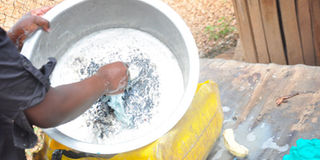Scour clean your pans with less difficulty

Scour the pan clean after dealing with the stubborn coatings . Photos by Isaac Ssejombwe
You know too well how much grease elbow goes into making those saucepans, stainless steel dishes and cooking pots shinny and clean. And yet, cooking leaves them in a rather messy state, especially if you are using a charcoal stove and firewood. Very often, the smoke leaves dirty brown marks outside the saucepan or totally covers the shinny silver with a black smoke coating, which usually proves hard to remove. Besides, the smoke, sometimes food gets burnt, leaving a hard-to-remove coating in the saucepan.
To make this job easy for you, Harriet Nimusiima, a professional cleaner at Spotoff Cleaners, shares a few tips on getting those pans shinny again.
“Some of the stubborn coatings to have on your saucepans are oil coatings/ burns that come as a result of overheating the cooking oil, so it leaves a brown coating on the sides or bottom of the saucepan, smoke coatings caused by smoke produced by charcoal or firewood and burnt food that gets stuck in the pan. However, all these are workable and removable,” Nimusiima notes.
To remove burnt food, which usually gets stuck in the pan, pour water into the pan and let it cover the burnt food, and around the corners of the pan. Put the pan on fire to get the water boiling for a reasonable period of time or until the food starts to softly come off.
Pour out the boiled water, and clean the pan with a scouring pad until thoroughly clean. Rinse and wipe dry.
“Usually, when people have food stuck in their saucepans, they get a spoon and try to scoop the food out, which normally leaves the pan scratched and looking old. This is wrong. If you can’t have the water boiled, just pour water into the saucepan and let it seat for about 30 minutes before scouring it clean,” she cautions.
To remove cooking oil residues, mix baking soda with a little water to make a paste. Apply the paste to the stained areas and let it set for about 10 minutes before scouring the pan clean. It is always important that one removes oil residues the moment they realise them. “What happens is that someone will cook from that same saucepan for a couple of times before they scrub the oil residue off, thus, making it more rigid and hard to remove. So, for hard to remove stains, you may need to use steel wool for a smarter look,” Nimusiima says.
And finally, for strong cooking oil residues and smoke-filled saucepan surfaces, stronger measures can be employed. The first option will be using steel wool to replenish the pan, since it has more grip and roughness that can have the smoke off.
“However, for stronger smoke coatings, use hydrogen peroxide. This is a bleaching agent and an antiseptic that will help you easily get those stains and smoke off. In water used for scouring that saucepan, add a good amount of hydrogen peroxide and a scouring powder or soap. Soak the side of the pan you want to scrub for a few minutes and use a scouring pad or steel wool to scrub clean. Scrub until desired results are attained. Rinse and dry/ polish pan dry,” she explains.
Avoiding smoke stains
To avoid smoke coatings, especially when cooking on firewood, mix ash with water to make a paste. Apply the paste on the surface of the source pan to make a thick coating. Leave to dry and use saucepan. This way, the smoke will stop at the ash coating instead of getting directly onto the source pan. After cooking, one can just scrub off the dried ash paste and the pan will shine again.




